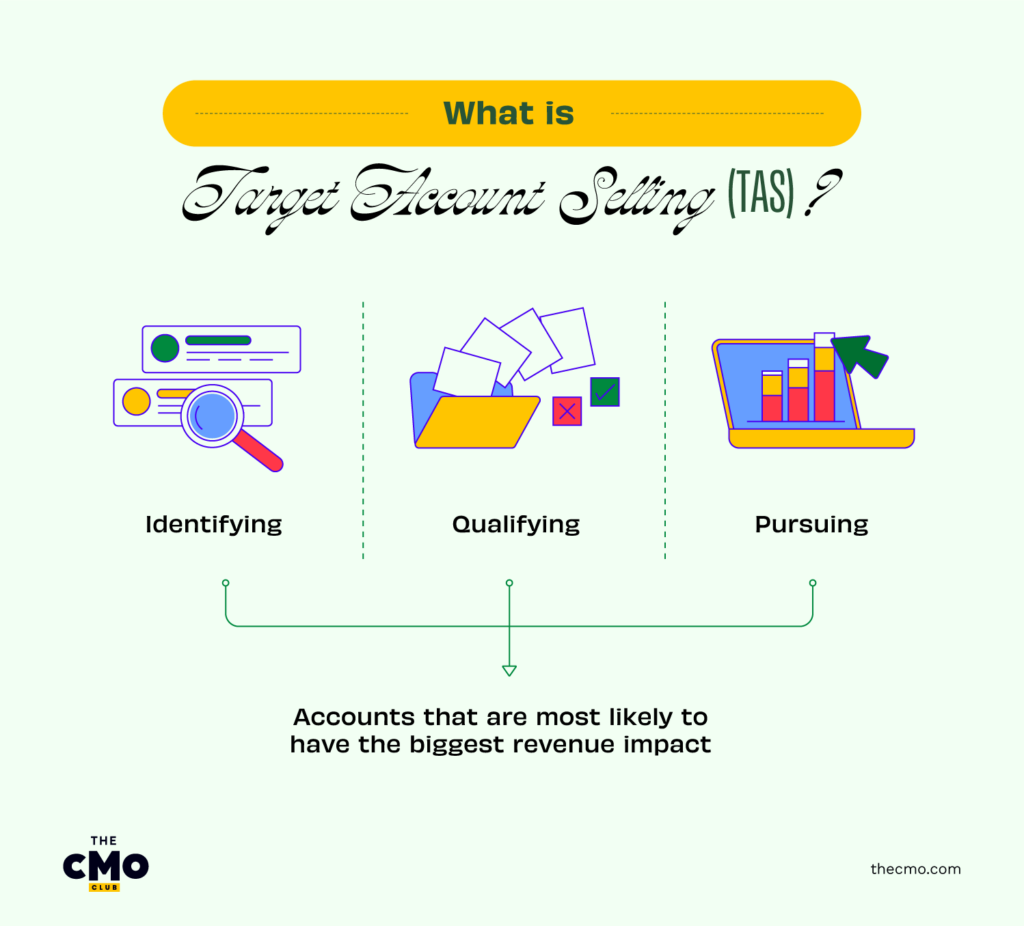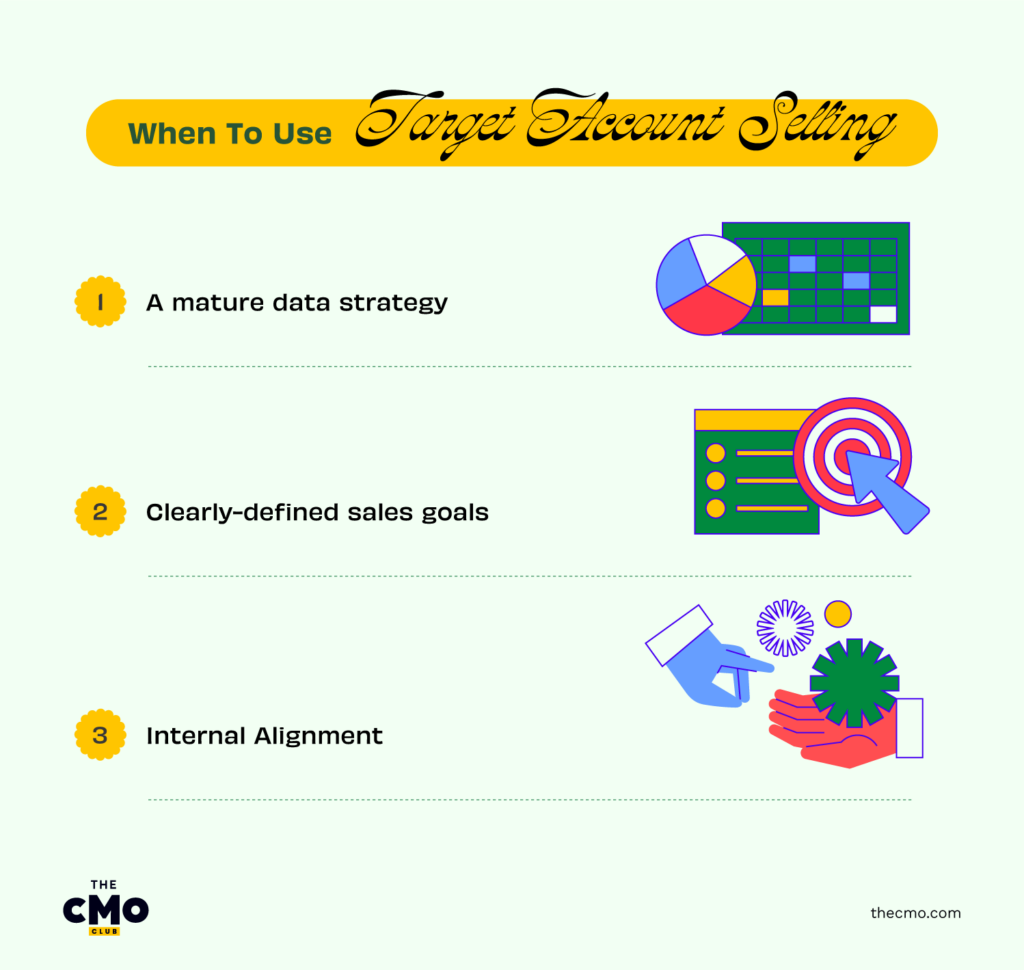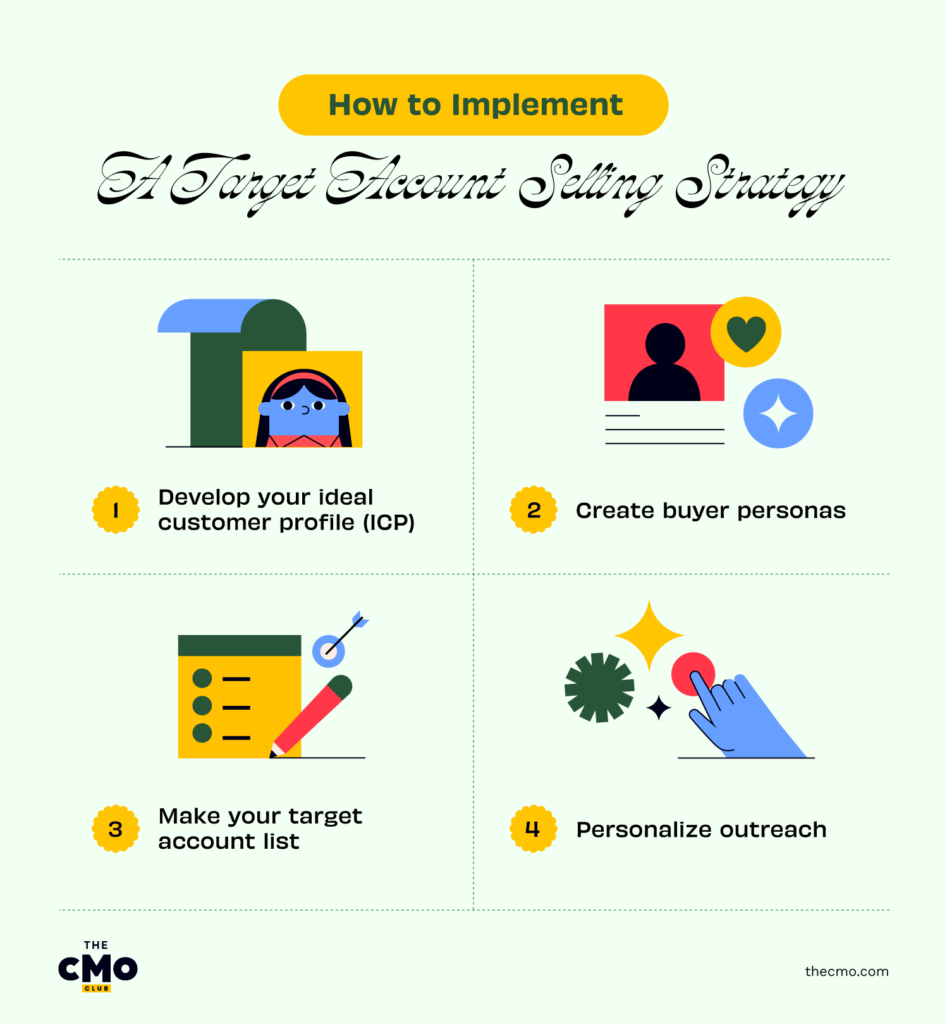In a time where precision and personalized marketing reign supreme, Target Account Selling (TAS) serves as the compass that guides B2B sales pros toward success. By honing in on high-value accounts and tailoring marketing strategies to client-specific needs, TAS offers a streamlined pathway to not just closing deals, but forging client relationships that drive sustainable growth.
In this guide, I’ll explore what TAS is, why it's important, and provide actionable tips to implement a target account selling strategy at your B2B organization.

What Is Target Account Selling (TAS)?
Target account selling is a sales strategy where sales teams identify, qualify, and pursue high-potential accounts that are likely to provide the biggest revenue impact. Instead of spreading sales efforts thin across many accounts, TAS uses account-based marketing, ABM software, and CRMs to focus resources on fewer accounts that align with your ideal customer profile.
The goal for TAS is to align sales and marketing to target premium accounts, build relationships with clients, and become a trusted partner. When done right, TAS provides higher win rates, deal sizes, and long-term retention.
Why Is TAS Important?
Target Account Selling (TAS) is crucial for businesses because it focuses resources on high-value opportunities, leading to increased revenue and stronger customer relationships.
According to a recent Salesforce report, 89% of stakeholders are more likely to buy from salespeople who understand their mission and goals. Additionally, 71% of B2B buyers reported that most sales interactions felt transactional.
TAS can be beneficial as it facilitates a better understanding of the buyer’s needs by enabling sales teams to tailor their approach to individual accounts, increasing the likelihood of closing deals and fostering customer loyalty.
How Does The Target Account Selling Methodology Work?
The key stages of TAS focus sales efforts on the best-bet accounts, while also providing a framework to open, develop and retain those accounts over time. It's about working smarter, rather than harder when it comes to B2B selling.
Rather than a broad, transactional approach, target selling is about strategic account management and aiming for long-term relationships. Executed properly, it aligns the sales funnel with marketing and customer success with key accounts to maximize their lifetime value.

When To Use Target Account Selling
Target account selling is most effective for closing large, complex B2B deals that require coordination across multiple key decision-makers. The focused account-based marketing strategy helps sales teams navigate long sales cycles and build consensus among various buying group members.
If your sales team is spending too much time chasing smaller transactions or prospects that fail to convert, a TAS strategy can help prioritize resources on accounts that offer bigger payouts. However, there are a few key considerations before adopting this sales methodology:
Key consideration 1: A mature data strategy
Target selling relies on having robust intent data to identify, score, and segment accounts with accuracy. This requires having a lead scoring methodology, clean customer data, and intent monitoring capabilities. Without the data, it’s hard to strategically select the accounts worth targeting.
Key consideration 2: Clearly defined sales goals
If you know you have a solid data foundation, the next consideration requires having SMART goals and objectives. Get alignment on the business objectives that the target selling approach will address. A few examples include increasing deal sizes, reducing sales cycles, and retaining accounts longer. If you don’t have clear goals, then you won’t know where you’re headed or what you’re trying to achieve. It is essential to measuring and tracking success.
To effectively measure the success of your target account selling strategy, it's important to track relevant metrics. Review the benefits of adopting ABM to see how it can provide valuable insights into your sales performance.
Key consideration 3: Internal alignment
Once you have figured out what you want to accomplish with TAS, the next consideration requires internal teams to get on the same page. For coordinated account-based selling, the sales team, marketing team, customer success team and leadership team should be aligned on who are the target accounts and the overall approach. Misalignment can result in wasted efforts as teams work across purposes.
Benefits of Target Account Selling
Improved customer relationships
Target account selling allows sales teams to devote more time to truly understanding the needs of key accounts, nurturing relationships across the organization, and providing ongoing value. This level of care and partnership builds lasting connections and loyalty with customers. To strengthen relationships, sales teams should avoid common ABM mistakes by maintaining constant proximity with target accounts through consistent touchpoints.
More avid brand advocates
When target accounts are highly satisfied and see your company as a trusted partner, they become powerful advocates for your brand. Satisfied customers will actively refer your business to industry peers, provide referrals or introductions, and strengthen your reputation in the long run. The goal is to deliver such a positive customer experience through strategic account management that your customers essentially sell for you.
Increased CLTV
A core benefit of long-term account focus is increased customer lifetime value. By targeting multiple business units and promoting cross-selling within strategic accounts, TAS generates more revenue during the entire customer relationship. Work to expand existing relationships through upsells, renewals, and new product lines.
More revenue generated
With concentrated efforts on key accounts, sales teams will see larger deal sizes, shorter sales cycles, and higher win rates. The focused energy pays dividends in hard revenue results. Target selling provides the framework to efficiently hit sales goals by prioritizing resources on the accounts that matter.
Less time wasted
Target account selling saves sales reps from wasting efforts on the wrong prospects. By identifying and qualifying high-potential accounts upfront, sales activities focus on accounts worth pursuing. Lead scoring, predictive analytics, and list refinement give focus to outreach. Make sure to prioritize target accounts and filter out unqualified prospects much earlier in the sales cycle.
Challenges of Target Account Selling
Time spent researching accounts
While proper targeting is crucial, it can also be time-consuming. Too much time researching accounts cut into selling time. Set limits for lead qualification to keep the sales process moving smoothly. Work closely with marketing teams to leverage their knowledge on ideal customers and get a deep understanding of their wants and needs.
Selecting only perfect accounts
Sales teams may get too selective, waiting for "perfect" accounts that check every box, which is not realistic. Criteria doesn’t need to be limiting, keep it broad enough to first build a robust initial target list that provides sufficient options. Pro tip: Always add and remove accounts as you learn to keep customer data organized and relevant.
Some accounts will say no
Unfortunately, even ideal targets may not be ready to buy or see the need. Expect some rejection along the way but persist through multiple contacts and value demonstrations. Nurturing initially cold accounts for future sales cycles can be really beneficial.

How To Implement A Target Account Selling Strategy
1. Develop your ideal customer profile (ICP)
Creating a detailed ideal customer profile is crucial for identifying the highest potential accounts to pursue. Profile your ideal customer in terms of business criteria like company size, industry, location, and revenue range. Also include behavioral criteria like core business challenges, goals, purchasing motivations, and buying process. With a clear ICP, you can zero in on accounts that align and offer maximum value. Don’t skip this important first step, take the time to be selective in defining your ideal customer and dream big!
2. Create buyer personas
Next, build out specific buyer personas that match your ICP roles in the decision-making process. For each customer persona, include specific details like job title, responsibilities, day-to-day challenges, goals, motivations, and general objections. Having a deep understanding of your ideal buyer personas allows you to craft personalized web content and messaging that truly resonates with each buyer based on their unique perspective and needs.
3. Make your target account list
Leverage your ICP definition and buyer personas to create a strong initial list of target accounts. Blend together the business-focused data, buying signals, intent data, and predictive lead scoring to identify around 100-500 target accounts. Be sure to include a healthy mix of existing customers, previous opportunities, new companies that fit your ICP, and aspirational accounts.
4. Personalize outreach
The key to success with target account selling is tailoring all interactions and messaging specifically for each company. The goal should be demonstrating that you truly understand each account’s needs, goals, and pain points. Take extra time to personalize messaging, collateral, and talking points for each target company. The relevancy will surely capture decision-makers' attention.
Here are some examples of personalized outreach:
- Use existing customer connections or warm introductions when possible to shorten sales cycles.
- Send personalized video messages when initially connecting with new contacts at a target account.
- Craft email messaging and copy with the specific pain points and goals of that account in mind.
- Provide case studies and success stories on your ABM landing page showing results from similar accounts.
- Ask thoughtful questions specific to the challenges and situation at the account during sales calls.
- Follow-up conversations with unique value tailored to what was discussed and promised.
The Strategic Power of Target Account Selling
Target account selling is a proven methodology to increase sales effectiveness, especially for complex B2B deals. By focusing resources on qualified, high-potential accounts, sales teams gain efficiency and higher win rates.
Key benefits of TAS include improved customer relationships through account focus, increased lifetime value and revenue, and avoiding wasted efforts on unqualified leads. However, proper execution does require upfront work in identifying the ideal accounts and personalizing outreach.
As B2B buying journeys get more complicated, target selling provides a way to cut through noise and focus energy where it matters most. For today's sellers, there is too much pressure to justify marketing spend and prove ROI to waste budget on broad outreach.
Start by defining your ideal customer profile and building that target account list. Follow the tips in this guide to personalize messaging and engage your ideal buyers, and be sure to subscribe to The CMO newsletter more great tips.


